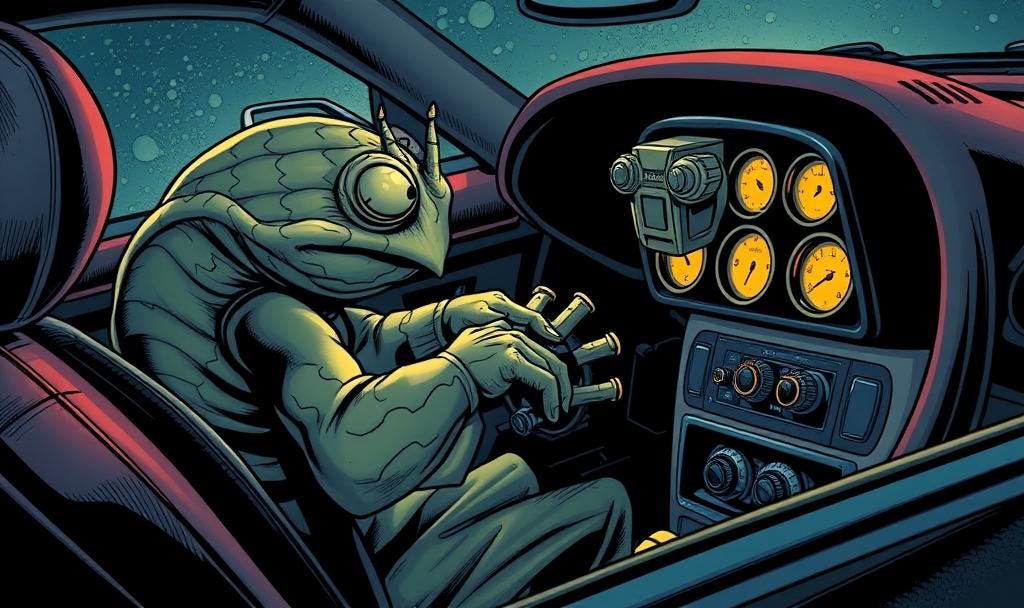Advance of the Nanny State
Maybe not all bad?
Earlier this month, I needed to hire a motor car. It was a Nissan Juke – a modest little four-seater saloon car. I like changing gears myself, so I asked for a manual gear change model. Those among you who have followed this blog for a while will recall my January lament that whizzy engineers have designed out the fun, the skill, the art and all satisfaction from modern motor cars.
I admit, some of those complaints hovered at the back of my mind as I went through the process of booking the vehicle and proving my identity at the sales counter.
The American scientist Bill Nigh, (The Science Guy), who made science for kids ‘cool’, was fond of saying, ‘An ounce of experimentation is worth a pound of theory’.
So, I set out to prove for myself what I have come around to believe.
My journey was around three hundred and fifty, mostly motorway, miles. I repeated it four times – two round trips. Not much opportunity for gear changing on motorways, I thought, so expected little satisfaction. That said, there were some wiggly stretches between the motorways and (because this is Great Britain) lots of traffic to slow progress.
Road designers tell us about a phenomenon they call the ‘Worm Effect’. A motorway driver eases off his accelerator pedal. Perhaps he was going too fast and wants to drop below the speed limit. That causes the car behind to brush his brakes lightly. The third car in line sees the brake lights and brakes more firmly. The fourth driver really stands on the brake pedal – this over-reaction continues until someone brings their car to a complete halt and engages the handbrake, as though parked.
Of course, space opens in front of the stopped vehicle rapidly, so he accelerates hard. Delayed driver reactions mean the following car doesn’t start to move until he is well under way, gathering speed and disappearing into the distance.
Viewed from above, this vehicle movement pattern must resemble the stretching and compressing motion of a worm. Hence the name.
I digress. Suffice to say I had lots of opportunity to change gears – and brake and accelerate while watching my mirror like a hawk in case somebody didn’t realise I was slowing or even stationary.
I admit I was charmed by the little car. It seemed eager to do whatever I wanted – to speed up, to adjust position in the lane and, once or twice, to stop on a sixpence when disaster had to be averted.
But it wasn’t all rosy. I discovered that a ‘safety’ mechanism tries to prevent the car moving across a white line unless you are indicating.
When I was taught to drive, use of the indicator was to tell other road users what I wanted to do. It was only to be used if someone else could make use of the information. If there are no other road users who might benefit from my signal, I should not give it. This discipline demands that the driver be aware of all other road users at all times. Using mirrors and doing shoulder checks help here. ‘Roadcraft’, the manual used by British Police forces, teaches that an indicator should flash at least four times before a manoeuvre begins. How many times do you see drivers start to move out at the same time or even before their indicator flashes?
If I tried to move the little car into another lane without signalling, it fought me – its brakes were applied automatically and the steering forced me back into the original lane. The only way to change lane was to signal I wanted to do so – whether it helped anyone else or not.
In my view, Lane Assist technology encourages people to use the indicator to suppress its braking and steering correction function rather than to inform and warn others.
I found it ridiculous that I had to signal to change lanes on a deserted roadway. And I found it worrying that my car would resist an emergency avoidance manoeuvre when the last thing on my mind would be using the indicator stalk.
Perhaps this function can be turned off? If it was mine, I would search the handbook to find out how to do it.
A personal bugbear of mine is waiting behind someone’s car when they insist on pressing the foot brake instead of applying the handbrake. At night, especially when it’s raining, those bright red lights are really annoying. Yet the Juke taught me its engine would cut out (to save fuel) when I waited at traffic lights all the time I pressed the foot brake. Maybe those with automatic gearboxes don’t use hand brakes?
I sympathise with them, because the Juke’s hand brake was an electronic on/off switch rather than a proper lever. To engage it is easy. You lift the switch. But to release the handbrake, it’s tricky to balance its release against engagement of the clutch. Moreover, you have to press the footbrake to make the release effective! What..?
Bear with me, please. A skill I learned fifty years ago was hill starts involving simultaneous use of the foot brake and accelerator pedals as the clutch comes up – in case the handbrake doesn’t work well or even fails. I’ve always said I cannot dance – but in view of the necessary fancy footwork demanded of the driver of a modern manual motorcar, perhaps I just haven’t discovered the knack of dancing.
I complained in the first paragraph that designers have removed all the fun and satisfaction from driving. But I really did enjoy the three pedal dancing challenge I describe above. And took great satisfaction from mastering it. It required many hundreds of miles of practice, mind. Perhaps I was too severe in my dismissive conclusions.
Now, how can you do hand brake turns with these? Very useful when driving in snow…



